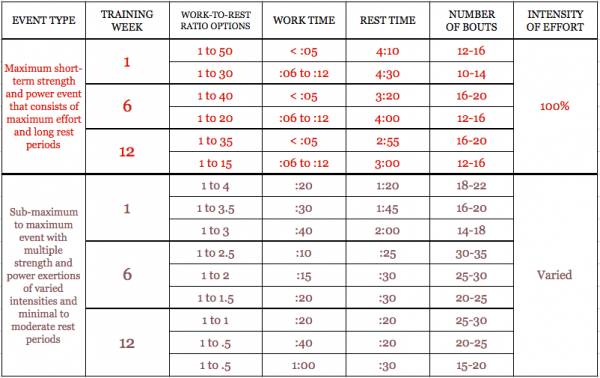In the 23 years I spent as a strength and conditioning coach at the collegiate level, much of it was dedicated to enhancing the conditioning component of my athletes. Conditioning was the process of preparing athletes for the energy demands of the sport in which they were involved. The goal was to maximize their endurance in their sport. My job was to prepare athletes to be able to perform at top ability throughout the duration of important competitions. Interval training was used as a part of the overall strength and conditioning program to achieve that goal.
Interval training involves a work period for a specified duration, followed by a recovery period with either no or minimal exertion. This work-rest menu is repeated for a specified number of repetitions (bouts) depending upon the training goal, the time of year of the training session, and the current conditioning level of the athletes.
The benefit of interval training is that it’s a fantastic means of improving cardio-vascular endurance beyond the use of steady-state work. It also adds more variety to a training program in that many different type of intervals can be used. Finally, it can be used in a sport-specific manner by replicating your sport skills repetitively with contest-specific work and rest periods.
Most interval training programs start with a break-in period that employs a minimum number of bouts, sub-maximal exertion effort, and maximum rest periods between bouts. Here are two examples of that:
400 meter running intervals – week one:
- Bouts – 3
- Work-to-rest ratio – 1 to 3
- Work effort (target time) – 1:35
- Rest period between bouts – 4:45
Boot camp station intervals – week one:
- Number of bouts (stations) – 16 (2 rounds of 8 stations)
- Work-to-rest ratio – 1 to 1.5
- Station work time – :30
- Rest period between stations – :45
Now, to be progressive and push abilities forward, the interval prescription would need to evolve to something more challenging than the above. Progressing from the week one examples above, here is what it might look like over time:
400 meter running intervals – week eight:
- Bouts – 6
- Work-to-rest ratio – 1 to 2
- Target time – 1:15
- Rest period between bouts – 2:30
Boot camp station intervals – week eight:
- Number of stations – 30 (3 rounds of 10 stations)
- Work-to-rest ratio – 1 to .5
- Station work time – :45
- Rest period between stations – :23
That makes perfect sense, but what is good for you? What are the best work and rest periods for your specific training goals? To determine this, first you need to analyze your event needs:
- What is the total time of your event?
- What is the length of time of the individual bouts (skill executions) that occur during your event?
- Are there varied bout lengths (i.e., some are short-term explosive and some require longer-term sub-maximal)?
- What is the intensity level of each bout? Again, maximal or sub-maximal effort?
- How many bouts are performed over the duration of your event?
- Does your event require multiple short-duration, all-out efforts with minimal rest between them?
- Does your event require multiple long-duration, sub-maximal efforts with varied rest times between them?
- Does your event entail maximal effort but with longer rest between bouts?
Whatever sort of athlete you are, you must attempt to replicate your competition needs in training. For a little more insight into your training needs, review the ATP-PC, glycolytic, and oxidative energy systems. But regardless of the science behind it, you’ll most likely in one of two categories:
1. A maximum short-term strength and power event that consists of maximum effort and lengthy rest periods, such as:
- Baseball position player
- Bowling
- Field event in track and field
- Golf
- Powerlifting
- Swimming short sprinter
- Track short sprinter
- Weightlifting
2. A sub-maximum to maximum event with multiple strength and power exertions of varied intensities and minimal to moderate rest periods, such as:
- Basketball
- Football
- Hockey
- Lacrosse
- Racquetball
- Soccer
- Tennis
- Volleyball
Whatever your event needs, here are practical work-to-rest ratio guidelines you can apply to your training using a twelve-week training program as an example.

This is just one example and yes it can be confusing. There are numerous work-to-rest options that can be used depending on the event needs, the time of year, and ability of the athlete. Therefore, when structuring work an rest periods within an interval training program, these guidelines can be helpful:
Maximum short-term exertion (<:12) and maximum rest time events (3:00+) – use shorter work periods and longer rest periods, such as 1 to 50, 1 to 40, or 1 to 30. The volume of bouts can vary depending on your needs. As a general rule, a lower volume in the early stages of a program and a higher volume in the latter stages.
Sub-maximum to maximum exertion (:20 to 1:00+) and minimal to moderate rest time events (:20 to 2:00) – use ratios such as 1 to 4, 1 to 2.5, 1 to .5. Again, the volume of bouts can vary depending on your needs: progress from a lower volume to a higher volume over the weeks of your training program.
Photo courtesy of Shutterstock.






